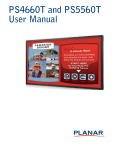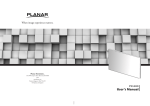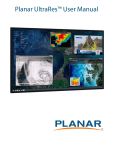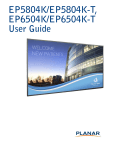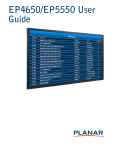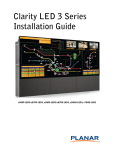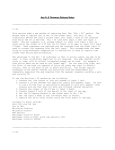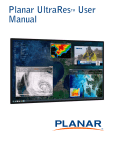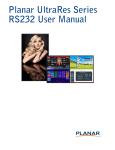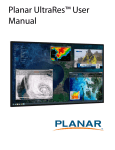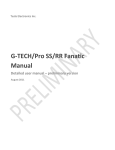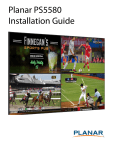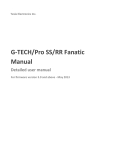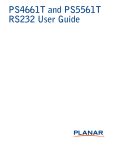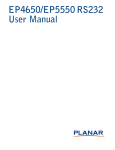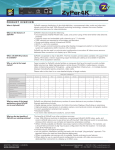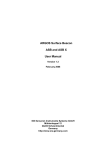Download UltraRes Installation Guide.book
Transcript
Planar UltraRes User
Manual
TM
Copyright © 14 May 2013 by Planar Systems, Inc. All rights reserved.
Contents of this publication may not be reproduced in any form without permission of Planar
Systems, Inc.
Trademark Credits
Windows™ is a trademark of Microsoft Corp.
Planar's Big Picture™ is a trademark of Planar Systems, Inc.
All other names are trademarks or registered trademarks of their respective companies.
Disclaimer
The information contained in this document is subject to change without notice. Planar
Systems, Inc. makes no warranty of any kind with regard to this material. While every
precaution has been taken in the preparation of this manual, the Company shall not be liable
for errors or omissions contained herein or for incidental or consequential damages in
connection with the furnishing, performance, or use of this material.
Warranty and Service Plans
Planar warranty and service plans will help you maximize your investment by providing great
support, display uptime, and performance optimization. From post-sale technical support to
a full suite of depot services, our services are performed by trained Planar employees. When
you purchase a Planar product, you get more than a display, you get the service and support
you need to maximize your investment. To find the latest warranty and service information
regarding your Planar product, please visit http://www.planarcontrolroom.com/support
RoHS Compliance Statement
The Planar UltraRes 4K professional displays are fully RoHS compliant.
ADA Compliance Statement
All Planar UltraRes 4K professional displays are compliant with the Americans with
Disabilities Act.
Part Number: 020-1229-00A
Copyright © 22 Mar 2013 by Planar Systems, Inc. All rights reserved.
Contents of this publication may not be reproduced in any form without permission of Planar
Systems, Inc.
Trademark Credits
Windows™ is a trademark of Microsoft Corp.
Planar's Big Picture™ is a trademark of Planar Systems, Inc.
All other names are trademarks or registered trademarks of their respective companies.
Disclaimer
The information contained in this document is subject to change without notice. Planar
Systems, Inc. makes no warranty of any kind with regard to this material. While every
precaution has been taken in the preparation of this manual, the Company shall not be liable
for errors or omissions contained herein or for incidental or consequential damages in
connection with the furnishing, performance, or use of this material.
Warranty and Service Plans
Planar warranty and service plans will help you maximize your investment by providing great
support, display uptime, and performance optimization. From post-sale technical support to
a full suite of depot services, our services are performed by trained Planar employees. When
you purchase a Planar product, you get more than a display, you get the service and support
you need to maximize your investment. To find the latest warranty and service information
regarding your Planar product, please visit http://www.planarcontrolroom.com/support
RoHS Compliance Statement
The Planar UltraRes 4K professional displays are fully RoHS compliant.
ADA Compliance Statement
All Planar UltraRes 4K professional displays are compliant with the Americans with
Disabilities Act.
Part Number: 020-1229-00A
Table of Contents
Introduction . . . . . . . . . . . . . . . . . . . . . . . . . . . . . . . . . . . . . . . . . . . . . . . . . . . . . . . . . . . . . . . . . . . . . . . . . . . . . . . . . . . . . . .1
Important Safety Instructions . . . . . . . . . . . . . . . . . . . . . . . . . . . . . . . . . . . . . . . . . . . . . . . . . . . . . . . . . . . . . . .2
European Union Disposal Information. . . . . . . . . . . . . . . . . . . . . . . . . . . . . . . . . . . . . . . . . . . . . . . . . . . . . . .4
Recommended Usage . . . . . . . . . . . . . . . . . . . . . . . . . . . . . . . . . . . . . . . . . . . . . . . . . . . . . . . . . . . . . . . . . . . . . . . . . . . .5
Burn-In Versus Temporary Image Retention . . . . . . . . . . . . . . . . . . . . . . . . . . . . . . . . . . . . . . . . . . . . . . . . .5
Normal Use Thermal Guidelines . . . . . . . . . . . . . . . . . . . . . . . . . . . . . . . . . . . . . . . . . . . . . . . . . . . . . . . . . . . . .6
Basic Concept of Planar UltraRes Display . . . . . . . . . . . . . . . . . . . . . . . . . . . . . . . . . . . . . . . . . . . . . . . . . . . . . . . . . .7
Using the Remote Control . . . . . . . . . . . . . . . . . . . . . . . . . . . . . . . . . . . . . . . . . . . . . . . . . . . . . . . . . . . . . . . . . . . . . . . .8
Turning Power On/Off . . . . . . . . . . . . . . . . . . . . . . . . . . . . . . . . . . . . . . . . . . . . . . . . . . . . . . . . . . . . . . . . . . . . . . . . . . . .9
Input Setup . . . . . . . . . . . . . . . . . . . . . . . . . . . . . . . . . . . . . . . . . . . . . . . . . . . . . . . . . . . . . . . . . . . . . . . . . . . . . . . . . . . . . .9
Supported Formats for Multiple Inputs . . . . . . . . . . . . . . . . . . . . . . . . . . . . . . . . . . . . . . . . . . . . . . . . . . . . . .9
Supported Formats for Single Inputs . . . . . . . . . . . . . . . . . . . . . . . . . . . . . . . . . . . . . . . . . . . . . . . . . . . . . . . .9
Installing a Planar UltraRes Display . . . . . . . . . . . . . . . . . . . . . . . . . . . . . . . . . . . . . . . . . . . . . . . . . . . . . . . . . . . . . . 11
Before You Begin . . . . . . . . . . . . . . . . . . . . . . . . . . . . . . . . . . . . . . . . . . . . . . . . . . . . . . . . . . . . . . . . . . . . . . . . . . . . . . .
Tools/Equipment List . . . . . . . . . . . . . . . . . . . . . . . . . . . . . . . . . . . . . . . . . . . . . . . . . . . . . . . . . . . . . . . . . . . . .
Other Things You May Need . . . . . . . . . . . . . . . . . . . . . . . . . . . . . . . . . . . . . . . . . . . . . . . . . . . . . . . . . . . . . .
Plan Your Installation . . . . . . . . . . . . . . . . . . . . . . . . . . . . . . . . . . . . . . . . . . . . . . . . . . . . . . . . . . . . . . . . . . . . .
11
11
11
11
Supported Graphics Cards . . . . . . . . . . . . . . . . . . . . . . . . . . . . . . . . . . . . . . . . . . . . . . . . . . . . . . . . . . . . . . . . . . . . . . 12
Recommended PCs. . . . . . . . . . . . . . . . . . . . . . . . . . . . . . . . . . . . . . . . . . . . . . . . . . . . . . . . . . . . . . . . . . . . . . . . . . . . . 12
Powering On/Off Planar UltraRes Displays . . . . . . . . . . . . . . . . . . . . . . . . . . . . . . . . . . . . . . . . . . . . . . . . . . . . . . . 13
Planar UltraRes in Standby Mode. . . . . . . . . . . . . . . . . . . . . . . . . . . . . . . . . . . . . . . . . . . . . . . . . . . . . . . . . . 14
Unpacking and Checking Accessories . . . . . . . . . . . . . . . . . . . . . . . . . . . . . . . . . . . . . . . . . . . . . . . . . . . . . . . . . . . 17
LCD Module Box. . . . . . . . . . . . . . . . . . . . . . . . . . . . . . . . . . . . . . . . . . . . . . . . . . . . . . . . . . . . . . . . . . . . . . . . . . 17
Accessory Kit . . . . . . . . . . . . . . . . . . . . . . . . . . . . . . . . . . . . . . . . . . . . . . . . . . . . . . . . . . . . . . . . . . . . . . . . . . . . . 19
Planar UltraRes User Manual
i
Table of Contents
LCD Installation. . . . . . . . . . . . . . . . . . . . . . . . . . . . . . . . . . . . . . . . . . . . . . . . . . . . . . . . . . . . . . . . . . . . . . . . . . . . . . . . . . .21
Installing an UltraRes Display on a Wall . . . . . . . . . . . . . . . . . . . . . . . . . . . . . . . . . . . . . . . . . . . . . . . . . . . . . . . . . .22
Using the Kickstand Bracket . . . . . . . . . . . . . . . . . . . . . . . . . . . . . . . . . . . . . . . . . . . . . . . . . . . . . . . . . . . . . . .29
Connections . . . . . . . . . . . . . . . . . . . . . . . . . . . . . . . . . . . . . . . . . . . . . . . . . . . . . . . . . . . . . . . . . . . . . . . . . . . . . . . . . . . .30
Connecting AC Power . . . . . . . . . . . . . . . . . . . . . . . . . . . . . . . . . . . . . . . . . . . . . . . . . . . . . . . . . . . . . . . . . . . . .30
Connecting the Wired IR Module. . . . . . . . . . . . . . . . . . . . . . . . . . . . . . . . . . . . . . . . . . . . . . . . . . . . . . . . . . .30
Connecting Sources . . . . . . . . . . . . . . . . . . . . . . . . . . . . . . . . . . . . . . . . . . . . . . . . . . . . . . . . . . . . . . . . . . . . . . .31
Setting Up UltraRes Using Multiple Inputs . . . . . . . . . . . . . . . . . . . . . . . . . . . . . . . . . . . . . . . . . . . . . . . . . .32
Setting Up UltraRes Using Single Inputs . . . . . . . . . . . . . . . . . . . . . . . . . . . . . . . . . . . . . . . . . . . . . . . . . . . .34
Installing the UltraRes Control Software . . . . . . . . . . . . . . . . . . . . . . . . . . . . . . . . . . . . . . . . . . . . . . . . . . . . . . . . .37
Installing USB Drivers. . . . . . . . . . . . . . . . . . . . . . . . . . . . . . . . . . . . . . . . . . . . . . . . . . . . . . . . . . . . . . . . . . . . . . . . . . . .40
Using the UltraRes Control Software . . . . . . . . . . . . . . . . . . . . . . . . . . . . . . . . . . . . . . . . . . . . . . . . . . . . . . . . . . . . .42
Setting Up Sources . . . . . . . . . . . . . . . . . . . . . . . . . . . . . . . . . . . . . . . . . . . . . . . . . . . . . . . . . . . . . . . . . . . . . . . . . . . . . .44
Auto Power Off Timer . . . . . . . . . . . . . . . . . . . . . . . . . . . . . . . . . . . . . . . . . . . . . . . . . . . . . . . . . . . . . . . . . . . . . . . . . . .45
Standby Mode . . . . . . . . . . . . . . . . . . . . . . . . . . . . . . . . . . . . . . . . . . . . . . . . . . . . . . . . . . . . . . . . . . . . . . . . . . . . . . . . . .45
Changing Backlight Intensity . . . . . . . . . . . . . . . . . . . . . . . . . . . . . . . . . . . . . . . . . . . . . . . . . . . . . . . . . . . . . . . . . . . .46
Turning Local Dimming On or Off. . . . . . . . . . . . . . . . . . . . . . . . . . . . . . . . . . . . . . . . . . . . . . . . . . . . . . . . . . . . . . . .46
Changing Frame Delay . . . . . . . . . . . . . . . . . . . . . . . . . . . . . . . . . . . . . . . . . . . . . . . . . . . . . . . . . . . . . . . . . . . . . . . . . .46
Upgrading Firmware . . . . . . . . . . . . . . . . . . . . . . . . . . . . . . . . . . . . . . . . . . . . . . . . . . . . . . . . . . . . . . . . . . . . . . . . . . . .47
Error Codes . . . . . . . . . . . . . . . . . . . . . . . . . . . . . . . . . . . . . . . . . . . . . . . . . . . . . . . . . . . . . . . . . . . . . . . . . . . . . . . . . . . . .50
UltraRes Dimensions. . . . . . . . . . . . . . . . . . . . . . . . . . . . . . . . . . . . . . . . . . . . . . . . . . . . . . . . . . . . . . . . . . . . . . . . . . . . . .51
Display Dimensions - Front and Side Views. . . . . . . . . . . . . . . . . . . . . . . . . . . . . . . . . . . . . . . . . . . . . . . . . . . . . . .51
Display Dimensions - Rear View. . . . . . . . . . . . . . . . . . . . . . . . . . . . . . . . . . . . . . . . . . . . . . . . . . . . . . . . . . . . . . . . . .52
Landscape Wall Mounts - Front View. . . . . . . . . . . . . . . . . . . . . . . . . . . . . . . . . . . . . . . . . . . . . . . . . . . . . . . . . . . . .53
Landscape Wall Mounts - Sides Views . . . . . . . . . . . . . . . . . . . . . . . . . . . . . . . . . . . . . . . . . . . . . . . . . . . . . . . . . . . .54
Portrait Wall Mounts - Front View . . . . . . . . . . . . . . . . . . . . . . . . . . . . . . . . . . . . . . . . . . . . . . . . . . . . . . . . . . . . . . . .55
Portrait Wall Mounts - Sides Views . . . . . . . . . . . . . . . . . . . . . . . . . . . . . . . . . . . . . . . . . . . . . . . . . . . . . . . . . . . . . . .56
Optional Pedestal Mount - Front View . . . . . . . . . . . . . . . . . . . . . . . . . . . . . . . . . . . . . . . . . . . . . . . . . . . . . . . . . . .57
ii
Planar UltraRes User Manual
Table of Contents
Optional Pedestal Mount - Top and Bottom Views . . . . . . . . . . . . . . . . . . . . . . . . . . . . . . . . . . . . . . . . . . . . . . . 58
Optional Pedestal Mount - Single and Double Sided . . . . . . . . . . . . . . . . . . . . . . . . . . . . . . . . . . . . . . . . . . . . . 59
Planar UltraRes Remote Monitoring Software. . . . . . . . . . . . . . . . . . . . . . . . . . . . . . . . . . . . . . . . . . . . . . . . . . . .
Remote Monitoring Home . . . . . . . . . . . . . . . . . . . . . . . . . . . . . . . . . . . . . . . . . . . . . . . . . . . . . . . . . . . . . . . .
Unit Status . . . . . . . . . . . . . . . . . . . . . . . . . . . . . . . . . . . . . . . . . . . . . . . . . . . . . . . . . . . . . . . . . . . . . . . . . . . . . . .
Display Control . . . . . . . . . . . . . . . . . . . . . . . . . . . . . . . . . . . . . . . . . . . . . . . . . . . . . . . . . . . . . . . . . . . . . . . . . . .
Admin Setup . . . . . . . . . . . . . . . . . . . . . . . . . . . . . . . . . . . . . . . . . . . . . . . . . . . . . . . . . . . . . . . . . . . . . . . . . . . . .
Reboot . . . . . . . . . . . . . . . . . . . . . . . . . . . . . . . . . . . . . . . . . . . . . . . . . . . . . . . . . . . . . . . . . . . . . . . . . . . . . . . . . . .
61
61
62
62
66
72
RS232 Communication . . . . . . . . . . . . . . . . . . . . . . . . . . . . . . . . . . . . . . . . . . . . . . . . . . . . . . . . . . . . . . . . . . . . . . . . .
Connecting the RS232 Cable . . . . . . . . . . . . . . . . . . . . . . . . . . . . . . . . . . . . . . . . . . . . . . . . . . . . . . . . . . . . . .
Setting Up Multiple Inputs . . . . . . . . . . . . . . . . . . . . . . . . . . . . . . . . . . . . . . . . . . . . . . . . . . . . . . . . . . . . . . . .
Setting Up Single Inputs . . . . . . . . . . . . . . . . . . . . . . . . . . . . . . . . . . . . . . . . . . . . . . . . . . . . . . . . . . . . . . . . . .
73
73
73
74
RS232 Commands . . . . . . . . . . . . . . . . . . . . . . . . . . . . . . . . . . . . . . . . . . . . . . . . . . . . . . . . . . . . . . . . . . . . . . . . . . . . . . 75
Command Format. . . . . . . . . . . . . . . . . . . . . . . . . . . . . . . . . . . . . . . . . . . . . . . . . . . . . . . . . . . . . . . . . . . . . . . . . . . . . . 75
Response Format. . . . . . . . . . . . . . . . . . . . . . . . . . . . . . . . . . . . . . . . . . . . . . . . . . . . . . . . . . . . . . . . . . . . . . . . . . . . . . . 76
Command/Response Examples . . . . . . . . . . . . . . . . . . . . . . . . . . . . . . . . . . . . . . . . . . . . . . . . . . . . . . . . . . . 77
Supported UltraRes 4K Commands. . . . . . . . . . . . . . . . . . . . . . . . . . . . . . . . . . . . . . . . . . . . . . . . . . . . . . . . . . . . . . 78
Specifications . . . . . . . . . . . . . . . . . . . . . . . . . . . . . . . . . . . . . . . . . . . . . . . . . . . . . . . . . . . . . . . . . . . . . . . . . . . . . . . . . . . . 81
Signal Compatibility . . . . . . . . . . . . . . . . . . . . . . . . . . . . . . . . . . . . . . . . . . . . . . . . . . . . . . . . . . . . . . . . . . . . . . . . . . . . 83
Troubleshooting During Installation. . . . . . . . . . . . . . . . . . . . . . . . . . . . . . . . . . . . . . . . . . . . . . . . . . . . . . . . . . . . . 85
Error Codes in the UltraRes Control Software . . . . . . . . . . . . . . . . . . . . . . . . . . . . . . . . . . . . . . . . . . . . . . . . . . . . 85
Symptoms, Possible Causes and Solutions . . . . . . . . . . . . . . . . . . . . . . . . . . . . . . . . . . . . . . . . . . . . . . . . . . . . . . 87
Symptom: Can’t Get PC to Output 4K @ 24/30Hz. . . . . . . . . . . . . . . . . . . . . . . . . . . . . . . . . . . . . . . . . . . 87
Accessing Planar’s Technical Support Website . . . . . . . . . . . . . . . . . . . . . . . . . . . . . . . . . . . . . . . . . . . . . . . . . . . 89
Downloading Additional Documentation and Firmware . . . . . . . . . . . . . . . . . . . . . . . . . . . . . . . . . . . . . . . . . 89
Downloading Utility Software. . . . . . . . . . . . . . . . . . . . . . . . . . . . . . . . . . . . . . . . . . . . . . . . . . . . . . . . . . . . . . . . . . . 89
Regulatory Information. . . . . . . . . . . . . . . . . . . . . . . . . . . . . . . . . . . . . . . . . . . . . . . . . . . . . . . . . . . . . . . . . . . . . . . . . . 91
Planar UltraRes User Manual
iii
Table of Contents
iv
Planar UltraRes User Manual
Introduction
Planar UltraRes 4K professional display is a family of 84” Ultra HD displays that
produce resolution and picture quality not before seen in large format LCD displays.
There are three different offerings: the UR8450-LX, UR8450-MX and the UR8450-3D.
Designed specifically for resolution-rich commercial applications, Planar UltraRes
displays offer the image quality, connectivity, industrial design and configuration
options required in leading control rooms, collaboration rooms and digital branding
installations.
Some of the features of the UltraRes display are:
• Ultra HD (3840 x 2160) resolution
• Outstanding picture quality - 4x pixel density of a comparably-sized Full HD
display
• Slim design with Planar ProfileTM Mounting System (about 3” deep when
mounted)
• Supports range of 4K sources and timings
• Energy-saving features include LEDs, <0.5 watt standby mode and auto-off
signal detection
Caution: This manual is intended for use by qualified service persons and end users with
experience installing LCD displays.
Planar UltraRes User Manual
1
Important Safety Instructions
1
Read these instructions.
2
Keep these instructions.
3
Heed all warnings.
4
Follow all instructions.
5
Do not use any of the Planar UltraRes products near water.
6
Clean the LCD screens with an LCD screen cleaner or LCD wipes.
7
Do not install near any heat sources such as radiators, heat registers, stoves or
other apparatus (including amplifiers) that produce heat.
8
Do not defeat the safety purpose of the polarized or grounding type plug. A
polarized plug has two blades with one wider than the other. A grounding type
plug has two blades and a third grounding prong. The wide blade or the third
prong is provided for your safety. When the provided plug does not fit into your
outlet, consult an electrician for the replacement of the obsolete outlet.
9
Protect the power cord from being walked on or pinched particularly at plugs,
convenience receptacles and the point where they exit from any of the Planar
UltraRes products.
10 Only use the attachments/accessories specified by the manufacturer.
11 Unplug all Planar UltraRes displays during lightning storms or when unused for
long periods of time.
12 You must follow all National Electrical Code regulations. In addition, be aware of
local codes and ordinances when installing your system.
13 Refer all servicing to qualified service personnel. Servicing is required when any
of the Planar UltraRes products have been damaged in any way, such as the AC
power cord or plug is damaged, liquid has been spilled or objects have fallen into
a product, the products have been exposed to rain or moisture, do not operate
normally or have been dropped.
14 Keep the packing material in case the equipment should ever need to be
shipped.
15 Wall mounts must be secure. The wall must be strong enough to hold the
UltraRes display, mounts and cables.
2
Planar UltraRes User Manual
16 Slight pressure on the LCD will cause distortion of the image. Heavier pressure
will cause permanent damage. Planar UltraRes configurations should be
mounted where viewers cannot touch the screen or insert small objects in the
openings that will create hazards by contacting bare conductive parts.
Caution: The front polarizer is soft and subject to scratches from sharp objects.
17 The polarizer is a thin sheet of film laminated to the outside layer of glass on the
LCD screen. Take care when handling items near the screen.
Planar UltraRes User Manual
3
European Union Disposal Information
English
■ Disposal of old Electrical & Electronic Equipment (Applicable throughout
the European Union and other European countries with separate collection
programs)
Français
■ Mise au rebut des équipements électriques et électroniques usagés
(Valable dans l’ensemble de l’Union Européenne ainsi que dans les pays
européens disposant de programmes distincts de collecte des déchets)
This symbol found on your product or on its packaging, indicates that
this product should not be treated as household waste when you wish to
dispose of it. Instead, it should be handed over to an applicable collection
point for the recycling of electrical and electronic equipment. By ensuring
this product is disposed of correctly, you will help prevent potential
negative consequences to the environment and human health, which
could otherwise be caused by inappropriate disposal of this product. The
recycling of materials will help to conserve natural resources.
Ce symbole appliqué sur votre produit ou sur son emballage indique
que ce produit ne doit pas être traité comme un déchet ménager lorsque
vous voulez le mettre au rebut. Il doit au contraire être remis à un site
de collecte agréé pour le recyclage des équipements électriques et
électroniques. En veillant à ce que ce produit soit mis au rebut de façon
adéquate, vous contribuerez à prévenir les conséquences potentiellement
négatives sur l’environnement et sur la santé humaine qui risqueraient
de se produire en cas de mise au rebut inappropriée de ce produit. Le
recyclage des matériaux contribuera également à économiser les ressources naturelles.
Dieses Symbol, zu finden auf Ihrem Produkt oder dessen Verpackung,
macht Sie darauf aufmerksam, dass dieses Produkt bei der Entsorgung
nicht als Hausmüll behandelt werden darf. Statt dessen sollte es an eine
Sammelstelle zum Recycling von elektrischen und elektronischen Altgeräten gegeben werden. Helfen Sie mit, potenziell schädliche Einflüsse
auf Umwelt und Gesundheit, die durch eine unsachgemäße Entsorgung
dieses Produktes entstehen können, zu vermeiden und entsorgen Sie
dieses Produkt ordnungsgemäß. Recycling hilft, natürliche Rohstoffe
einzusparen.
This symbol is only valid in the European Union.
If you wish to discard this product, please contact
your local authorities or dealer and ask for the correct method of disposal.
Ce symbole n’est valable que dans l’Union Européenne.
Si vous souhaitez mettre ce produit au rebut, veuillez
prendre contact avec les autorités locales ou avec votre
revendeur et renseignez-vous sur la méthode de mise
au rebut correcte.
Dieses Symbol ist nur innerhalb der europäischen
Gemeinschaft gültig.
Wenn Sie dieses Produkt entsorgen möchten, wenden
Sie sich bitte an Ihre örtliche Behörde und fragen Sie
nach der ordnungsgemäßen Entsorgungsmethode.
Español
■ Deshecho de equipos eléctricos y electrónicos (aplicable a la Unión Europea y a otros países europeos con programas de reciclaje independientes)
La presencia de este símbolo en el propio producto o en su material de
embalaje, indica que no se debe tratar como residuo doméstico cuando
desee deshacerse de él. En su lugar, debe entregarlo en el punto limpio
correspondiente de reciclaje de equipos eléctricos y electrónicos. Asegurándose de que este producto se desecha de forma correcta, ayudará
a evitar posibles consecuencias negativas para la conservación del
medioambiente y la salud humana, consecuencias que podrían darse si
se deshace del producto de forma inadecuada. El reciclado de materiales
ayuda a conservar los recursos naturales.
Este símbolo solamente es válido en la Unión
Europea.
Si desea deshacerse de este producto, póngase
en contacto con las autoridades locales o con su
distribuidor y pida información sobre el método de
disposición adecuado.
Italiano
■ Smaltimento delle attrezzature elettriche ed elettroniche usate (applicabile
in tutta la Comunità Europea ed altri Paesi Europei che applicano
programmi di raccolta differenziata)
Il simbolo trovato sul prodotto, o sulla sua confezione, indica che il
prodotto non può essere trattato come i domestici quando è il momento
di smaltirlo. Al contrario, deve essere consegnato ad un centro di raccolta
specializzato nel riciclaggio di attrezzature elettriche ed elettroniche. Assicurando che il corretto smaltimento di questo prodotto, si aiuterà a prevenire potenziali conseguenze negative sull’ambiente e sulla salute umana,
che possono essere provocate da uno scorretto smaltimento di questa
attrezzatura. I materiali riciclati aiuteranno a conservare le risorse naturali.
Questo simbolo è valido solo nell’Unione Europea.
Per smaltire questo prodotto, mettersi in contatto con
le autorità locali – o con il rivenditore – e chiedere
informazioni sul corretto metodo di smaltimento.
Português
■ Eliminação de equipamentos eléctricos e electrónicos usados (aplicável
na União Europeia e noutros países europeus com programas próprios de
recolha destes equipamentos)
Este símbolo, colocado no produto ou na respectiva embalagem, indica
que o produto não deve ser tratado como lixo doméstico aquando da sua
eliminação. Em vez disso, deve ser entregue num ponto de recolha de equipamentos eléctricos e electrónicos para posterior reciclagem. Ao garantir
a correcta eliminação deste produto, estará a evitar consequências potencialmente negativas tanto para o ambiente como para a saúde humana. A
reciclagem de materiais ajuda a preservar os recursos naturais.
Este símbolo apenas é válido na União Europeia.
Se quiser eliminar este produto, contacte as entidades locais ou o seu fornecedor para ficar a saber
qual o método de eliminação correcto.
■ Avfall av förbrukad elektrisk och elektronisk utrustning (Tillämpbart i
hela Europeiska unionen och andra europeiska länder med separata
samlingsprogram)
Den här symbolen som finns på din product eller på dess förpackning
påvisar att produkten inte ska behandlas som hushållsavfall när du vill
slänga bort den. Istället ska den lämnas över till en lämplig uppsamlingspunkt för återvinning av elektriska och elektroniska utrustningar. Genom att
tillförsäkra att den här produkten återvinns på ett riktigt sätt hjälper du till
med att förhindra möjliga negative konsekvenser för miljön och mänsklig
hälsa. Det kan annars orsakas på grund av olämplig sophantering av den
här produkten. Återvinning av material kommer att hjälpa till att bevara
naturtillgångar.
Den här symbolen är endast giltig inom den
Europeiska unionen.
Om du vill slänga bort den här produkten ska du
kontakta lokala myndigheter eller återförsäljar, och
fråga efter lämplig avfallsmetod.
Nederlands
■ Verwijderen van oude elektrische en elektronische apparatuur (toepasselijk in de volledige Europese Unie en andere Europese landen met
afzonderlijke programma’s voor afvalverzameling)
Dit symbool dat op het product of zijn verpakking is aangebracht, geeft aan
dat dit product niet mag worden behandeld als huishoudelijk afval als u het
wilt wegwerpen. U moet het afgeven bij een specifiek verzamelpunt voor
de recyclage van elektrische en elektronische apparatuur. Door te garanderen dat u dit product op de correcte manier wegwerpt, helpt u potentiële
negatieve gevolgen voor het milieu en de menselijke gezondheid, die
zouden kunnen worden veroorzaakt door een onrechtmatig wegwerpen
van het product, te voorkomen. De recyclage van materialen helpt het
behoud van natuurlijke bronnen.
Dit symbool is alleen geldig in de Europese Unie.
Als u dit product wenst weg te gooien, dient u contact op
te nemen met uw lokale instanties voor details over de
gepaste methode voor afvalverwijdering.
Polski
■ Usuwanie zużytego sprzętu elektrycznego i elektronicznego (Dotyczy
krajów Unii Europejskiej i innych krajów europejskich z oddzielnymi
programami zbiórki odpadów)
Obecność tego symbolu na produkcie lub na opakowaniu z produktem
oznacza, że tego produktu nie można wyrzucać razem z odpadkami
domowymi. Należy go przekazać do punktu zbiórki w celu poddania
recyklingowi podzespołów elektrycznych i elektronicznych. Usunięcie tego
produktu w prawidłowy sposób, pomoże w zabezpieczeniu przed negatywnym wpływem odpadów na środowisko i zdrowie ludzi, powodowanym
przez niewłaściwe usuwanie produktu. Przetwarzanie materiałów pomaga
w zachowaniu zasobów naturalnych.
Ten symbol obowiązuje wyłącznie w krajach Unii
Europejskiej.
Informacje dotyczące prawidłowej metody usunięcia
tego produktu, można uzyskać u władz lokalnych lub
u dostawcy.
Svenska
4
Deutsch
■ Entsorgung von elektrischen & elektronischen Altgeräten (geltend für die
europäische Gemeinschaft und andere europäische Länder mit separaten
Sammelprogrammen)
Waste Electrical and Electronic Equipment (WEEE) Directive In the European Union, this label indicates that this product should not be disposed of with household waste. It should be deposited at an appropriate facility to enable recovery and recycling. EEE complies with Directive ‘Regulation on the Restriction of the Use of Certain Hazardous Substances in Electrical and Electronic Equipment’
Waste Electrical and Electronic Equipment (WEEE) Directive In the European Union, this label indicates that this product should not be disposed of with household waste. It should be deposited at an appropriate facility to enable recovery and recycling. EEE complies with Directive ‘Regulation on the Restriction of the Use of Certain Hazardous Substances in Electrical and Electronic Equipment’
Suomi
■ Vanhojen sähkö- ja elektroniikkalaitteiden hävittäminen (Soveltuva kaikkialla Euroopan unionin alueella, sekä muissa Euroopan maissa, joilla on
erilliset keräysohjelmat)
Jos tuotteessa tai sen pakkauksessa on tämä symboli, sitä ei pidä
hävitettäessä käsitellä tavallisena kotitalousjätteenä, vaan se kuuluu toimittaa sähkö- ja elektroniikkalaitteiden kierrätyspisteeseen. Varmistamalla,
että tämä tuote hävitetään asiaankuuluvalla tavalla autat estämään mahdollisia ympäristölle ja ihmisille koituvia negatiivisia seuraamuksia, joita
sen vääränlainen hävittäminen voi aiheuttaa. Materiaalien kierrättäminen
auttaa säilyttämään luonnonvaroja.
Tämä symboli on voimassa ainoastaan Euroopan
unionin alueella.
Jos haluat hävittää tämän tuotteen, ota yhteyttä
paikallisiin viranomaisiin tai jälleenmyyjään ja tiedustele
asiaankuuluvia hävittämistoimenpiteitä.
Planar UltraRes User Manual
Waste Electrical and Electronic Equipment (WEEE) Yönergeleri Avrupa Birliği'nde bu etiket, ürünün ev elektroniği aletleri atıkları ile imha edilemeyeceğini gösterir. Kurtarmak ve geri dönüşümünü sağlamak için uygun şartlarda saklanması gerekir. EEE Yönetmeliğine Uygundur Ve Elektronik Eşyalarda Bazi Zararli Maddelerin Kullaniminin Sinirlandirilmasina Dair Yönetmelik.
Waste Electrical and Electronic Equipment
(WEEE) Yönergeleri Avrupa Birliği'nde bu etiket,
ürünün ev elektroniği aletleri atıkları ile imha
edilemeyeceğini gösterir. Kurtarmak ve geri
dönüşümünü sağlamak için uygun şartlarda
saklanması gerekir. EEE Yönetmeliğine
Uygundur Ve Elektronik Eşyalarda Bazi Zararli
Maddelerin Kullaniminin Sinirlandirilmasina
Dair Yönetmelik.
Recommended Usage
Recommended Usage
In order to get the most out of your LCD modules, use the following recommended
guidelines to optimize the display.
Burn-In Versus Temporary Image Retention
Burn-in causes the screen to retain an image essentially forever, with little or no way
to correct the problem. Under normal use, an LCD module will not experience burnin, as plasma displays do, nor will it retain images in any way.
Normal use of an LCD module is defined as displaying continuously changing video
patterns or images. However, LCD modules can experience temporary image
retention when recommended usage guidelines are not followed.
What is Temporary Image Retention?
Temporary image retention (TIR) can occur when a static image is displayed
continuously for extended periods of time. An electrical charge differential may build
up between the electrodes of the liquid crystal, which causes a negative-color video
image (color-inverted and brightness-inverted version of the previous image) to be
retained when a new image is displayed. This behavior is true for any LCD device
from any LCD manufacturer.
TIR is not covered under warranty. See standard warranty terms and conditions for
details. Here are some guidelines to help you avoid TIR:
• Use the LCD module to show a screen saver, moving images or still pictures that
change regularly. When using high-contrast images, reposition the images
frequently.
• Turn off the Planar UltraRes when it is not in use. There are a few ways to do this
automatically.
Caution: For optimal performance, we suggest turning off the LED power on the Planar
UltraRes for four hours per day.
Planar UltraRes User Manual
5
Recommended Usage
Normal Use Thermal Guidelines
Normal use of the LCD module is defined as operating in the open air to prevent heat
buildup, and without direct or indirect heat sources such as lighting fixtures, heating
ducts, or direct sunlight that can cause the modules to experience high operating
temperatures. If the LCD module will be installed in a recessed area with an LCD
surround or enclosure, ensure adequate openings are applied for proper air flow and
ventilation.
At 3000 meters or below, the maximum ambient operating temperature for the LCD
module cannot be above 40º C nor below the minimum ambient operating
temperature of 10º C. If one of these conditions exists, it is up to the installer to
ensure that module placement is changed, thermal shielding is provided and/or
additional ventilation is provided to keep the display within its nominal operating
parameters.
Cooling Requirements
For optimal performance, active cooling by the installer should be planned for when
the ambient temperature anywhere in the wall is predicted to be above the specified
ambient temperature for the display.
6
Planar UltraRes User Manual
Basic Concept of Planar UltraRes Display
Basic Concept of Planar UltraRes Display
The Planar UltraRes display uses four separate outputs that feed into the 84” display
as one image. You can use any combination of HDMI, DisplayPort or DVI.
There are two main modes of operation for the UltraRes Display:
• Single 4K inputs @ 24/25/30Hz
• Four headed input (4K @ 60Hz)
Using four separate outputs provides the ultra HD resolution needed for superior
image quality. In the following example, each number represents an output. All four
“quadrants” (outputs) are fed into the 84” display and turned into one ultra highresolution image.
Planar UltraRes User Manual
7
Using the Remote Control
Using the Remote Control
The UltraRes remote control can be used for a variety of functions, including turning
the display on and off and assigning individual inputs.
Select individual inputs
Turn display
on/off
Select single
or multiple
input
connections
8
Planar UltraRes User Manual
Turning Power On/Off
Turning Power On/Off
There are several ways to turn the power on and off:
• Using the On/Off buttons on the remote control. See "Using the Remote
Control" on page 8 for more information.
• Using the Power On/Power Off buttons in the UltraRes Control software tool.
See "Using the UltraRes Control Software" on page 42 for detailed information
about the UltraRes Control software.
• Use the UltraRes Remote Monitoring software. See "Planar UltraRes Remote
Monitoring Software" on page 61.
Input Setup
You can set up your Planar UltraRes display using multiple or single inputs. Both are
explained below. You can select multiple or single input mode using the remote
control, the UltraRes Control tool or by using RS232 commands. For more
information see "Setting Up UltraRes Using Multiple Inputs" on page 32 and "Setting
Up UltraRes Using Single Inputs" on page 34.
Used to receive signals from
the remote control.
RS232 connector
Used to connect to the
Remote Monitoring software
Used to send serial commands to the
display. Also used for diagnostic purposes.
Supported Formats for Multiple Inputs
The following formats for multiple inputs are supported:
• (4x) DisplayPort or HDMI/DVI 1080p @ 24/50/60Hz
• PC with DisplayPort or HDMI/DVI (or mix of both)
• External video processors
• (4x) DisplayPort or HDMI/DVI 960 x 2160 @ 60Hz
• Needs a PC with a special graphics card setup
Supported Formats for Single Inputs
The following formats for single inputs are supported:
• (1x) DisplayPort or HDMI/4K@ 24/25/30Hz
• PC with DisplayPort 1.1a or 1.2 output
• 4K Blu-ray player (for example, Sony BDP-S790)
Planar UltraRes User Manual
9
Input Setup
10
Planar UltraRes User Manual
Installing a Planar
UltraRes Display
This section explains how to install a Planar UltraRes display. We suggest that you
read this entire section before you attempt to install a display.
Before You Begin
Make sure you have all the items in the following lists before you begin unpacking
and installing your display.
Tools/Equipment List
Depending on your installation, you may need one or more of the following items:
•
•
•
•
•
•
•
#1 and # 2 Phillips screwdriver
Drill and bits
Pencil
Digital/laser level
Ladders/lift
Back brace
Stud finder (if hanging on a wall)
Other Things You May Need
• LCD screen cleaner or LCD wipes - available at most electronics stores
• At least two capable people to lift display into place
Plan Your Installation
You should have a detailed plan of how the Planar UltraRes display is to be
configured. The plan should include calculations for the following:
• Floor/wall load. Make sure the floor/wall is strong enough to support the
weight of the Planar UltraRes.
• For passive cooling, it is recommended that a minimum of 1” of top clearance is
provided. This can be reduced if the LCD is actively cooled.
• Ventilation and cooling requirements. Although the rear cover of the display is
perforated and provides better airflow than other displays, it is still important
that you consider room cooling and ventilation.
Planar UltraRes User Manual
11
Supported Graphics Cards
Supported Graphics Cards
UltraRes supports a variety of graphics cards from leading manufacturers, such as
Nvdia and AMD. In general, you should be looking for graphics cards that have the
following features:
• Can output 3840 x 2160 at 24 Hz or 30 Hz over a single DisplayPort of HDMI
connection.
• Four-output graphics cards that can output synchronized (genlocked) 1920 x
1080 outputs at up to 60 Hz.
• Cards that support Planar’s support timings, as listed in the following section
"Compatible Video Sources" on page 83.
Caution: Before you purchase a graphics card for your source, contact your Sales
Representative to get the most current information on Planar’s compatibility with leading
graphics cards.
Recommended PCs
In order to use 4K video, it is crucial that you have a high-powered PC. We also
recommend using a single 4K output whenever possible, so that you eliminate the
requirement of multi-output synchronization.
12
Planar UltraRes User Manual
Powering On/Off Planar UltraRes Displays
Powering On/Off Planar UltraRes Displays
There are several different ways to turn on or off the Planar UltraRes Display:
• Using the On/Off buttons on the remote control. See "Using the Remote
Control" on page 8 for more information.
• Using the Power On/Power Off buttons in the UltraRes Control software tool.
See "Using the UltraRes Control Software" on page 42 for detailed information
about the UltraRes Control software.
• Use the UltraRes Remote Monitoring software. See "Planar UltraRes Remote
Monitoring Software" on page 61.
Planar UltraRes User Manual
13
Powering On/Off Planar UltraRes Displays
Planar UltraRes in Standby Mode
If you are unsure about whether or not the display is on but in standby mode, look for
the small Standby LED. If it is off, you will not see the LED. If it is on but in Standby
mode, you will see a blue LED. As the display starts, the LED blinks until it is on. Once
it is on, the LED turns off.
Insert IR sensor cord
into the IR input on the
bottom of the display.
14
Planar UltraRes User Manual
Powering On/Off Planar UltraRes Displays
If an image is present on the current input, it will be displayed on the UltraRes
display. Otherwise, you will see a blank screen color (the default is black).
Planar UltraRes User Manual
15
Powering On/Off Planar UltraRes Displays
16
Planar UltraRes User Manual
Unpacking and Checking Accessories
Unpacking and Checking Accessories
LCD Module Box
The following items are included in the LCD module box.
Part
Description
Number
LCD module
One per box.
1
LCD mounts
(optional)
If ordered, this will be inside a
separate box inside the LCD
box.
1
Picture
Note: If you do not use
Planar’s mounts, you need to
ensure the mounts that you
purchase can adequately
support the display.
Mounting
template
Used to line up where the
wall mounts will be installed.
This is included with Planar’s
optional LCD mounts.
1
Planar UltraRes User Manual
17
Unpacking and Checking Accessories
Part
Description
Number
Kickstand
bracket
Mounts to the display when
Planar mounts are purchased.
1
M4 x 8
Panhead
screws
Used to mount the kickstand
bracket.
4
18
Planar UltraRes User Manual
Picture
Unpacking and Checking Accessories
Accessory Kit
The following items are included in the accessory kit.
Part
Description
Number
Included
AC power cord
Power cord.
1
IR sensor
Used to receive signals from
the remote control.
1
Double-sided
tape
Used to help in mounting
the IR sensor module.
2
USB drive
Contains the User Manual
and setup software.
1
Passive USB
cable
Used to set up display
software.
1
Remote control
Used to power the display
on/off, select multiple or
single inputs.
1
Picture
Note: Batteries are included
but not installed.
Planar UltraRes User Manual
19
Unpacking and Checking Accessories
20
Planar UltraRes User Manual
LCD Installation
Before installation, keep the following points in mind:
• These displays are heavy. Make sure that you have an adequate studs to
support the weight of each display if installing on a wall.
• The UltraRes must be installed on a flat surface.
• If you ordered the optional wall mounts, use the supplied UltraRes mounting
template for the center point of the display, as well as top and bottom bracket
installation.
• The wall mounts for a landscape and portrait installation look very similar. The
process to install them is almost exactly the same. The only difference is the way
in which you use the wall mount template. This will be pointed out in the
relevant step.
Planar UltraRes User Manual
21
Installing an UltraRes Display on a Wall
Installing an UltraRes Display on a Wall
Caution: For whatever structure is used to mount the display, be sure that it is sufficiently
engineered to handle the weight of the display. Also be sure to purchase the correct
hardware needed to support the display mounted to that structure.
22
1
Find the center point of the display on the wall where you intend to install it.
2
Draw a short (about 1”) horizontal line and a vertical line to match the edge of the
display.
Planar UltraRes User Manual
Installing an UltraRes Display on a Wall
Center notch alignment
3
Use the provided template to determine the center points of the wall mounts.
The “V” notches are labeled “L” for a landscape display or “P” for a portrait display.
Use the appropriate “V” notch to align with the horizontal line drawn in the
previous step.
Planar UltraRes User Manual
23
Installing an UltraRes Display on a Wall
4
In the hole marked “Top” on the template, mark the center of the hole on the wall.
Note: If you are installing a landscape display and the template is too long, you can break the
template at the notch labeled “P.”
24
5
Let the template hang vertically so it is plumb, as the bottom hole in the template
determines where the bottom mount will be installed.
6
Screw in the appropriate hardware in the bottom hole of the template that
corresponds with your display orientation.
7
Remove each screw and the template.
Planar UltraRes User Manual
Installing an UltraRes Display on a Wall
8
Line up the middle hole of the top wall mount with the screw hole drilled from
the template.
Note: This picture shows mounts for a landscape installation.
9
Tighten the screw into the mount.
10 Use a level to make sure the mount is level.
11 Then install additional screws as needed.
Note: Screws installed near the hooks provide the best support.
12 Install the center screw in the bottom mount and repeat steps 10-11 for any
additional screws that you want to install. Note that there are open mount
channels on the brackets. So you can install the screws wherever necessary along
those channels.
Planar UltraRes User Manual
25
Installing an UltraRes Display on a Wall
13 Install the kickstand bracket to the back of the display using four M4 x 8 Panhead
screws.
Landscape holes for kickstand bracket installation
Portrait kickstand installed on display
26
Planar UltraRes User Manual
Installing an UltraRes Display on a Wall
14 Using two people, carefully hang the back display onto the top wall mount
bracket using the square brackets on the back of the display.
Caution: Be sure that these are securely hung, as the top of the wall mount will hold most of
the weight of the display.
Planar UltraRes User Manual
27
Installing an UltraRes Display on a Wall
15 On the bottom wall mount, there is locking hardware in the bottom corners of
the mount. Push the hardware up and finger tighten the captive screws on the
bottom to secure the display to the wall.
28
Planar UltraRes User Manual
Installing an UltraRes Display on a Wall
Using the Kickstand Bracket
The kickstand bracket is used for service mode, without having to remove the display
from the wall. Use the following instructions to put the display in service mode.
1
Loosen the captive locking screws on both sides of the bottom mount.
2
Pull the display out and then swing out the kickstand to hold it in place. The
kickstand will nest into the kickstand bracket notch.
Service position with kickstand
supporting display
Planar UltraRes User Manual
29
Connections
Connections
In order to get your UltraRes display up and running, you need to make three main
connections: AC power to the display, the wired IR module and your sources.
Connecting AC Power
Using the supplied AC power cord, connect one end to a grounded outlet and the
other to the AC power input next to the I/O panel the bottom of the UltraRes display.
Connecting the Wired IR Module
In order for the remote control to work, you need to connect the wired IR module to
the display, also on the bottom of the I/O panel. Then place the IR receiver in the
desired place on or near the display.
30
Planar UltraRes User Manual
Connections
Connecting Sources
The graphics card that you install on your main PC will determine what outputs will
be plugged into the Planar UltraRes display. For example, some graphics cards have
two HDMI outputs and two DisplayPort outputs. Any combination of these outputs is
fine. Below is a visual example of how a basic connection might look.
In the example below, using four input channels on a computer, you would use one
connector to connect to for each input on the I/O panel on the UltraRes display, as
shown below.
As an example, you could use the following:
•
•
•
•
Input 1 - HDMI 1
Input 2 - DisplayPort 2
Input 3 - DisplayPort 3
Input 4 - HDMI 4
Note: You cannot plug into two ports on the same input channel. For example, you can’t
plug into HDMI 1 and DisplayPort 1 in Input 1 as shown above. You can only connect to one
input for each input channel.
Planar UltraRes User Manual
31
Connections
Setting Up UltraRes Using Multiple Inputs
You will have a computer that contains four video outputs. All four outputs will then
be connected to the UltraRes display. The following formats are supported for
multiple inputs:
• (4x) DisplayPort or HDMI/DVI 1080p @ 24/50/60Hz
• PC with DisplayPort or HDMI/DVI (or mix of both)
• External processors (VCS, RGB Spectrum)
• (4x) DisplayPort or HDMI/DVI 960 x 2160 @ 60Hz
• Needs a PC with a special graphics card setup
Using UltraRes Control Software
If you use the UltraRes Control software to set up multiple sources, there are three
different settings per input channel. Before continuing, make sure you have selected
the Multiple Inputs radio button in the lower left corner.
• Based on Input Source - This default option automatically selects the same type
of input as the current Input Source setting. For example, if you have four HDMI
input sources, this feature should detect that your sources are connected to
HDMI 1-4.
• Select Individual Inputs - The example below shows the circled inputs that were
selected individually.
32
Planar UltraRes User Manual
Connections
Below are two examples of setups in UltraRes Control software that are acceptable.
Planar UltraRes User Manual
33
Connections
Setting Up UltraRes Using Single Inputs
Instead of having one central device into which you can connect and define your
source inputs, single source setup requires connecting from a single-headed source
to the display. For example, connecting one input directly from a Blu-ray player into
the 84” display.
The example below uses the following:
• PC with 4K at 24/25/30HZ output
• 4K Blu-ray player, such as Sony BDP-S790
The following formats are supported for single inputs:
• (1x) DisplayPort or HDMI/4K@ 24/25/30Hz
• PC with DisplayPort 1.1a or 1.2 output
• 4K Blu-ray player (for example, Sony BDP-S790)
There are two preferred ways in which you can select individual inputs. They are
described on the following pages.
34
Planar UltraRes User Manual
Connections
Using the Remote Control
The UltraRes remote control has individual inputs that can be selected. So if this
UltraRes input is connected to HDMI 2, press the HDMI 2 button on the remote
control.
Planar UltraRes User Manual
35
Connections
Using the UltraRes Control Software
On the Source tab, select the input that is connected to the UltraRes display. For
example, if this UltraRes input is connected to HDMI 2, select the HDMI 2 radio
button in the Input Source section on the left.
36
Planar UltraRes User Manual
Installing the UltraRes
Control Software
The UltraRes Control software is used as your primary tool for display setup. Use the
following instructions to install the UltraRes Control software.
1
Save the UltraRes Control.exe program to your computer’s hard drive.
2
Double click the .exe file to open the installer program.
Planar UltraRes User Manual
37
38
3
Click Next to continue.
4
If you want to save the UltraRes Control files to a different location, click the
Browse button and save to the folder of your choice.
5
If you want to see how much space is on your hard drive, click the Disk Cost...
button to review storage capacity.
6
Do one of the following:
• If you want other users to have access to the UltraRes Control software, select
the Everyone radio button.
• If you want to be the only user who can access the UltraRes Control software,
select the Just me radio button.
7
Click Next to continue.
Planar UltraRes User Manual
8
Click Next on the next window to continue.
9
As the installation is occurring, you will see the status bar for up to a couple of
minutes.
Planar UltraRes User Manual
39
Installing USB Drivers
10 Once the installation is complete, click Close to close the program.
Installing USB Drivers
When you install the UltraRes Control software, it will automatically install the
necessary USB drivers needed for communication between your computer and to
the UltraRes display. You only need to complete a few steps to finish the installation
process.
40
1
Plug one end of the USB cable into your computer and the other into the UltraRes
display.
2
Windows will detect the new hardware and attempt to install the drivers. If this
occurs, you should see a message similar to the following example.
Planar UltraRes User Manual
Installing USB Drivers
3
If the USB driver installation is successful, you will see a message similar to the
example below. You are now done with the USB driver installation process.
Planar UltraRes User Manual
41
Installing USB Drivers
Using the UltraRes
Control Software
When you first open the UltraRes Control software, you will see a window similar to
the following. Notice that until you connect the inputs to the display, the “Status” at
the top of the window will show “Disconnected.”
42
1
Connect from the PC on which the software is installed to the UltraRes display
using a USB connection.
2
Click the Connect button to start the connection process.
Planar UltraRes User Manual
Installing USB Drivers
3
The tool will then attempt to auto detect any inputs that are already connected. If
one is detected, the following window appears with information already filled in.
Model name
Serial number
If no inputs are auto-detected, you will see a window similar to the following.
Notice all fields are grayed out and cannot be changed.
Planar UltraRes User Manual
43
Setting Up Sources
4
If the connection is successful, the “Status” at the top of the window will show
“Connected.” Note that all tabs are now accessible and can now be changed if
needed.
Setting Up Sources
This information is covered earlier in the manual. Please see "Setting Up UltraRes
Using Multiple Inputs" on page 32 and "Setting Up UltraRes Using Single Inputs" on
page 34 for setup information.
44
Planar UltraRes User Manual
Auto Power Off Timer
Auto Power Off Timer
If you want the power to automatically turn off if there is no incoming source for a
certain amount of time, use the AUTO POWER OFF TIMER slider on the Settings tab and
select between 1-60 seconds.
Standby Mode
This mode allows you to choose between a low power setting, which saves energy, or
a “fast startup” mode that keeps the AC power supplies running. Below each option is
described and why you might want to select it.
• Low Power - Powers off every component and board possible, which helps
conserve energy. In standby mode, the low power option only uses 0.5W of
power.
• Fast Startup - Keeps AC power supplies running takes a little less time to power
up and it is also needed if you intend to continually use networking capabilities.
Planar UltraRes User Manual
45
Changing Backlight Intensity
Changing Backlight Intensity
To change the brightness of the display, use the BACKLIGHT slider on the Display tab. If
you want a brighter display, move the slider towards a higher number. If you want to
conserve power and increase backlight life, move the slider towards a lower number.
Turning Local Dimming On or Off
Local Dimming allows the LED edge lighting to dynamically adjust based on the
source content. Turning this feature on shows darker black levels, which in turn has a
higher contrast ratio. Because this feature dims a large area at once, the performance
may not be as good as direct array LED backlighting.
Changing Frame Delay
With some quadrant sources, the top and bottom halves of display can show frame
tearing, at a delay of one frame per second. If you see frame tearing, use the TOP HALF
FRAME DISPLAY and BOTTOM HALF FRAME DELAY sliders to compensate.
46
Planar UltraRes User Manual
Upgrading Firmware
Upgrading Firmware
Upgrading software can only be done through the UltraRes Control software.
Note: Firmware upgrades can only be done over a USB connection.
1
Select the File menu bar and then Upgrade Firmware.
Planar UltraRes User Manual
47
Upgrading Firmware
2
A file called 4K.xml will be part of the release package. Navigate to this section
and click Open to begin the upgrade process.
Note: The upgrade can be initiated from ON or standby mode.
48
Planar UltraRes User Manual
Upgrading Firmware
3
The upgrade process will take about 40 minutes. Be sure you are prepared for
this amount of time before you initiate the upgrade process.
4
The upgrade process status bar will show where you are in the upgrade process
as the upgrade proceeds.
5
When the upgrade is complete, you will see a message box similar to the
following example.
Planar UltraRes User Manual
49
Error Codes
Error Codes
To see the last 50 errors that have occurred, select the Error Log tab in the UltraRes
Control software, as shown below. For a complete list of the error codes, see "Error
Codes in the UltraRes Control Software" on page 85.
50
Planar UltraRes User Manual
UltraRes Dimensions
Display Dimensions - Front and Side Views
Planar UltraRes User Manual
51
Display Dimensions - Rear View
Display Dimensions - Rear View
;0;02817+2/(6
6(59,&(3$1(/
/2&.6&5(:
86(3+
6(59,&(3$1(/
&$37,9(6&5(:6
52
Planar UltraRes User Manual
Landscape Wall Mounts - Front View
Landscape Wall Mounts - Front View
;3$1(/+$1*(5
',63/$<287/,1(
6(59,&(.,&.67$1'
3$1(//2&.6&5(:6
Planar UltraRes User Manual
53
Landscape Wall Mounts - Sides Views
Landscape Wall Mounts - Sides Views
&(,/,1*
0,18080
:$//
Installed position
54
Service position - with kickstand supporting display
Planar UltraRes User Manual
Portrait Wall Mounts - Front View
Portrait Wall Mounts - Front View
;3$1(/+$1*(5
',63/$<287/,1(
,23$1(/
$&,1/(7
6(59,&(.,&.67$1'
Planar UltraRes User Manual
3$1(//2&.6&5(:6
55
Portrait Wall Mounts - Sides Views
Portrait Wall Mounts - Sides Views
&(,/,1*
0,1,080
:$//
Installed position
56
Service position - with kickstand supporting display
Planar UltraRes User Manual
Optional Pedestal Mount - Front View
Optional Pedestal Mount - Front View
;3$1(/+$1*(5
7<3
',63/$<287/,1(
6(59,&(
.,&.67$1'
;3$1(//2&.
&/,36
Note: This view shows the pedestal without the display mounted on it.
Planar UltraRes User Manual
57
Optional Pedestal Mount - Top and Bottom Views
Optional Pedestal Mount - Top and Bottom Views
View is shown as if looking from above the top of the pedestal.
; 3('(67$/02817
+2/(6
&$%/($&&(66
View is shown as if looking at the bottom of the pedestal.
58
Planar UltraRes User Manual
Optional Pedestal Mount - Single and Double Sided
Optional Pedestal Mount - Single and Double Sided
5($575,0
6+((76,1*/(
3('(67$/21/<
81,7
81,7
81,7
6,1*/(6,'('
3('(67$/
;5(029$%/(75,0
)257,('2:1$1'
&$%/($&&(66
Single sided pedestal with display installed on one side
'28%/(6,'('
3('(67$/
Double sided pedestal with display installed on each side
Planar UltraRes User Manual
59
Optional Pedestal Mount - Single and Double Sided
60
Planar UltraRes User Manual
Planar UltraRes Remote Monitoring Software
Planar UltraRes Remote Monitoring Software
Planar UltraRes Remote Monitoring is software that displays information about the
display via a web browser. It is used primarily for monitoring, reporting and some
control (for example, manually powering the displays on and off ).
Remote Monitoring Home
This is the first page you will see when you open the Planar UltraRes Remote
Monitoring software.
Planar UltraRes User Manual
61
Planar UltraRes Remote Monitoring Software
Unit Status
The Unit Status page shows a list of the different system settings for the display,
including power, signal format and which sources are connected with which inputs. It
also shows all current firmware information, the display ID and the serial number of
the specific display.
Display Control
The Display Control page contains four sub-pages: Power On/Off, Source Setup, and
Advanced Setup. These are described in the following pages.
62
Planar UltraRes User Manual
Planar UltraRes Remote Monitoring Software
Power On/Off
Power On/Off buttons control the LED power, not the AC power. You cannot control
AC power through Planar UltraRes Remote Monitoring.
This section has four options for which you can schedule an automatic power on/off.
The options are: no automatic power on/off, same daily schedule, Monday-Friday
same schedule and weekends off. Or each day has its own schedule. You can only
select one of the schedule types. The default is No automatic power on/off.
Planar UltraRes User Manual
63
Planar UltraRes Remote Monitoring Software
Source Setup
The Source Setup page allows you to perform the same tasks that you can using the
UltraRes Control software: select single or multiple input model, select an input
source for each input in single input mode, and different options for selecting inputs
in multiple input mode.
64
Planar UltraRes User Manual
Planar UltraRes Remote Monitoring Software
Advanced Setup
The Advanced Setup page allows you to perform many of the same tasks that you
can on the UltraRes Control software program, including selecting the power mode
that works best for your display, which includes low power or fast startup. You can
also select many display settings such as backlight intensity, frame delay, color space
definitions and RGB settings.
Planar UltraRes User Manual
65
Planar UltraRes Remote Monitoring Software
Admin Setup
The Admin Setup page contains four sub-pages: Network Setup, Date and Time,
Access Control and Software Setup. These are described in the following pages.
66
Planar UltraRes User Manual
Planar UltraRes Remote Monitoring Software
Network Setup
This page allows you to configure network settings and whether or not you use
DHCP.
1
In the Hostname box it now says Planar. Change this name to something more
appropriate. This will be the name for this particular server. The hostname is
limited to 16 characters: alphanumeric, dash, or underscore only.
2
If you want to enter a domain name for server name lookups, type it in the
Domain name box.
3
Do one of the following:
• If you will use DHCP, go to step 4.
• If you will not use DHCP, go to step 5.
4
Under the DHCP section, choose Yes, use DHCP.
a Change the default DHCP timeout (ten seconds) only if instructed by your
network administrator.
Planar UltraRes User Manual
67
Planar UltraRes Remote Monitoring Software
b You do no need to fill in anything under the Static (non-DHCP) Network
Settings section. However, if you do, these settings will be used in the event
that the DHCP attempts to time out.
c Go to step 6.
5
Under the DHCP section, choose No, use static settings.
a In the Static (non-DHCP) Network Settings section, enter the IP address given
to you by the network administrator.
b Enter the Network mask, DNS server(s), and Gateway as instructed by the
network administrator.
c Go to step 6.
6
Scroll to the bottom of the page and click Confirm and apply new network
settings to receive the Confirm Network Change page.
7
Review the settings to make sure they are correct. Click OK, apply changes now
to receive the Applying Network Changes page. This shows the network settings
to be used.
Note: If you have changed the static IP address or changed from static to DHCP setup, you
may need to point your browser at the new address.
8
68
You may have to click the Refresh button on your browser to see the new name
in the upper left corner of the page.
Planar UltraRes User Manual
Planar UltraRes Remote Monitoring Software
Date and Time
Use this page to change date and time information as needed.
1
Set the date and time manually in the box under the Manual Date and Time
section. The date format is very exact. Fill in the current date and time using
exactly the format shown on the page. Click Set date and time.
2
If you want to have the server periodically check the time from a network source,
fill in the NTP server name or address, and poll interval in the Date and Time
Server section. Click Apply new date and time server settings.
Note: If you don’t have a preferred NTP server, then www. pool.ntp.org is a reasonable choice
for most installations.
3
Carefully read the instructions in the Local Time Zone section. Fill in the text box
and click Set time zone.
Note: The start and end of daylight saving time default to the first Sunday of April and the
last Sunday of October. As of 2007, U.S. locales that observe daylight saving time must enter
start and end dates in this section. For example, EST5EDT,M3.2.0,M11.1.0 is correct for U.S.
Eastern time zone as of 2007.
Planar UltraRes User Manual
69
Planar UltraRes Remote Monitoring Software
Access Control
The Access Control page allows you to set parameters needed to access the web, the
Remote Monitoring network, RS232 commands, as well as select the correct baud
rate.
70
Planar UltraRes User Manual
Planar UltraRes Remote Monitoring Software
Software Setup (Upgrading Network Firmware)
This page allows you to upload the latest UltraRes Remote Monitoring software. You
can also reset all of your settings to the factory defaults, as well as choose the web
page link that is associated with the Planar logo in the top right corner of the page.
1
Click the Choose File button to locate the latest UltraRes software that you
downloaded from Planar’s website.
Note: Make sure the software is downloaded to a local drive.
2
Click the Load Software button to load the new software. This process can take a
few minutes, depending on the speed of your network. It is very important that
you do not interrupt the load process once it begins.
3
If you want to reset ALL settings to the factory default, click the Reset ALL to
Factory Default button. This includes network settings, date and time, etc., as
well as display settings.
Caution: Using this option will reset all of your configurations and reboot the remote
monitor. Because this includes network settings, be aware that the UltraRes Remote
Planar UltraRes User Manual
71
Planar UltraRes Remote Monitoring Software
Monitoring software may not configure to the same network address after the system
reboots.
4
When you click Reset ALL to Factory Default, you receive the Confirm Factory
Reset page. Click OK, Reset to Factory Defaults and Reboot if you are sure you
want to reset ALL settings to the factory default.
5
The top of each page shows the Planar logo, which is a link to
http://www.planar.com. You can change this link to refer to any URL that you find
useful by typing it into the Product ID Link box.
6
To make this link live, click Change Product ID Link.
7
In normal operations, Remote Monitoring polls the displays at a rate of one per
second to look for user requests that have been made using the IR remote control
and the on-screen menus. In some situations, this polling can have a noticeable
performance impact. If you want to disable this polling, select the Disable
polling for alert conditions checkbox. When you are finished, click Change
Advanced Settings.
Reboot
Click Reboot now to reboot your system. The reboot takes about 90 seconds.
72
Planar UltraRes User Manual
RS232 Communication
RS232 Communication
RS232 control is not necessary for operation, but is a convenient way to control
displays from a computer at a distance. If your installation will not use RS232 control,
skip this section. Most things you can do with the remote, you can do with RS232
commands. Plus, you can send inquiries to the displays and find out the current
settings and values. RS232 connections are made with standard straight-through
cables.
Connecting the RS232 Cable
The RS232 cable will connect to a PC or control system, depending on your setup.
Setting Up Multiple Inputs
You can also set up multiple inputs using RS232 commands. As is typical with using
RS232 commands, you can pull up a basic program such as Tera Term to send
commands. Below is an small example.
Planar UltraRes User Manual
73
RS232 Communication
Setting Up Single Inputs
You can set up single inputs using RS232 commands. As is typical with using RS232
commands, you can pull up a basic program such as Tera Term to send commands.
Below is an small example.
74
Planar UltraRes User Manual
RS232 Commands
RS232 Commands
The RS232 connection must use the following settings:
•
•
•
•
•
19200 baud rate
8 data bits
1 stop bit
No parity bit
No HW (RTS/CTS) or SW (XON/XOFF) flow control
Command Format
Commands sent from the initiator to the follower must have the following format:
(www:xyz) [CR]
Where:
• ‘(‘ and ‘)’ indicate the start and end of the command data. If these characters are
present, the CLI processor shall assume that “valid” CLI data is present in the
command string. If these characters are not present in the command, the CLI
processor shall assume the data is not valid CLI data and ignore it.
• “www” indicates the command code. This field is case insensitive (i.e. “PWR”,
“pwr” and “PwR” should all be treated as “PWR”).
• “:x” is the destination parameter. This is an optional parameter that indicates
which memory the command is referencing. This parameter is reserved and
shall not be used at this time.
• “y” is the operand, which can have one of the following values:
• ‘?’ = “Get” operand
• ‘=’ = “Set” operand
• ‘+’ = “Increment” operand (not supported on 4K)
• ‘-‘ = “Decrement” operand (not supported on 4K)
• “z” is the value to set for this parameter. It can have one of two formats:
• Integer value: Any positive or negative number (example: 100)
• String value: Any string surrounded by double quotes (example: “This is a
string”)
• “[CR]” is the ASCII carriage return key (0x0D).
Planar UltraRes User Manual
75
Response Format
Response Format
Responses sent from the follower to the initiator shall have the following format:
(u;www:x=z) [CR]
Where:
• ‘(‘ and ‘)’ indicate the start and end of the command data. If these characters are
present, the CLI processor shall assume that “valid” CLI data is present in the
command string. If these characters are not present in the command, the CLI
processor shall assume the data is not valid CLI data and ignore it.
• “u;” indicates the response code. This is only used by followers responding to a
valid CLI command received. For any response code other than 0, the follower
shall echo back the command received rather than filling in the fields listed
below. The following response codes can be used:
• 0 = Command successfully processed
• 1 = Unknown command code
• 2 = Invalid operator
• 3 = Destination parameter not supported
• 4 = Setting not available
• 5 = Setting value not available
• 6 = Setting value not supported
• 7 = String too long
• 8 = Command not supported in standby mode
• 9 = Invalid parameter
• 10 = Error processing command
• 11 = Password not entered
• “www” indicates the command code sent by the follower. This field is case
insensitive (i.e. “PWR”, “pwr” and “PwR” should all be treated as “PWR”).
• “:x” is the destination parameter. This is an optional parameter that indicates
which memory the response is referencing. This parameter is reserved and shall
not be used at this time.
• “z” is the new value (for set/increment/decrement commands) or the current
value (for get commands) for this parameter. It can have one of two formats:
• Integer value: Any positive or negative number (example: 100)
• String value: Any string surrounded by double quotes (example: “This is a
string”)
• “[CR]” is the ASCII carriage return key (0x0D).
76
Planar UltraRes User Manual
Response Format
Command/Response Examples
The following section gives examples of commands and their responses:
Example:
Power query when unit is powered on
Command:
(PWR?) [CR]
Response:
(0;PWR=1) [CR]
Example:
Set power to 0 (off)
Command:
(PWR=0) [CR]
Response:
(0;PWR=0) [CR]
Example:
Increment brightness from 24 to 25
Command:
(BRT+) [CR]
Response:
(0;BRT=25) [CR]
Example:
Invalid command code
Command:
(ZZZ=0) [CR]
Response:
(1;ZZZ=0) [CR]
Example:
of int)
Invalid parameter (string instead
Command:
(CON=”Some string”) [CR]
Response:
(9;CON=”Some string”) [CR]
Planar UltraRes User Manual
77
Supported UltraRes 4K Commands
Supported UltraRes 4K Commands
The following section lists the commands that are currently support on the UltraRes
display.
Setting
Auto Power Off Enable
Command Code
APE
Read/
Write
Inc/Dec
R/W
No
Min Value
0
Max Value
1
String?
No
Password Protected?
No
Auto Power Off Timer
APT
R/W
No
1
60
No
No
Backlight
BKL
R/W
No
1
15
No
No
Notes
0 = Off
1 = On
Value is in minutes
Blank Screen Blue
BSB
R/W
Yes
0
255
No
No
Blank Screen Green
BSG
R/W
Yes
0
255
No
No
Blank Screen Red
BSR
R/W
Yes
0
255
No
No
Color Space
CLS
R/W
No
0
4
No
No
0 = REC601
1 = REC709
2 = RGB
3 = RGB Video
4 = Auto
EDID Type
EDT
R/W
No
0
1
No
No
0 = Default EDID
1 = 1080p EDID
Error Log 1
EL1
R
No
N/A
N/A
Yes
No
Response contains 50 hex digits
representing the first 25 entries in
the error log
Error Log 2
EL2
R
No
N/A
N/A
Yes
No
Response contains 50 hex digits
representing the second 25 entries
in the error log
Error Code
ERR
R
No
0
TBD
No
No
0 = None
1 = AC Power Supply 1 Failure
2 = AC Power Supply 2 Failure
3 = AC Power Supplies 1 and 2
Failure
4 = AC Power Supply 3 Failure
5 = AC Power Supplies 1 and 3
Failure
6 = AC Power Supplies 2 and 3
Failure
7 = AC Power Supplies 1, 2 and 3
Failure
8 = AC Power Status Cable
Disconnected
9 = DC Power Supply Failure
10 = FPGA Initialization Failure
11 = Calibration EEPROM Failure
12 = Overtemp
Bottom Frame Delay
FDB
R/W
No
0
2
No
No
Top Frame Delay
FDT
R/W
No
0
2
No
No
Firmware Upgrade
FWU
W
No
N/A
N/A
No
No
Information Boot
Version
IBV
R
No
N/A
N/A
Yes
No
Information Current
Color Space
ICC
R
No
0
3
No
No
78
Planar UltraRes User Manual
Action will be performed on any
setting value
0 = REC601
1 = REC709
2 = RGB
3 = RGB Video
Supported UltraRes 4K Commands
Command Code
IF1
Read/
Write
Inc/Dec
R
No
Min Value
N/A
Max Value
N/A
String?
Yes
Password Protected?
No
Information FPGA 2
Version
IF2
R
No
N/A
N/A
Yes
No
Information FPGA 3
Version
IF3
R
No
N/A
N/A
Yes
No
Information FPGA 4
Version
IF4
R
No
N/A
N/A
Yes
No
Information Firmware
Version
IFV
R
No
N/A
N/A
Yes
No
Input Mode
INM
R/W
No
0
2
No
No
0 = Single Input (Scaled)
1 = Single Input (Unscaled)
2 = Multiple Inputs
Input Source
INS
R/W
No
0
15
No
No
0 = DisplayPort 1
1 = DisplayPort 2
2 = DisplayPort 3
3 = DisplayPort 4
4 = HDMI 1
5 = HDMI 2
6 = HDMI 3
7 = HDMI 4
Setting
Information FPGA 1
Version
Notes
IP Address
IPA
R
No
N/A
N/A
Yes
No
Information Pixel Clock
IPC
R
No
N/A
N/A
Yes
No
Information Signal
Format
ISF
R
No
N/A
N/A
Yes
No
Information Serial
Number
ISN
R
No
N/A
N/A
Yes
No
Information
Temperature Sensor
ITS
R
No
N/A
N/A
No
No
Value returned is in Celsius
Remote Key
KEY
W
No
0
92
No
No
1 = On
2 = Off
3 = Menu
4 = Enter
5 = Up
6 = Down
7 = Left
8 = Right
19 = HDMI 1
20 = HDMI 2
21 = HDMI 3
22 = HDMI 4
85 = DisplayPort 1
87 = DisplayPort 2
88 = DisplayPort 3
89 = DisplayPort 4
90 = Single Input
91 = Multiple Inputs
92 = Previous
Local Dimming
LDM
R/W
No
0
1
No
No
0 = Off
1 = On
Model Name
MDL
R
No
N/A
N/A
Yes
No
Multiple Input 1
MI1
R/W
No
0
2
No
No
0 = Auto
1 = DisplayPort 1
2 = HDMI 1
Multiple Input 2
MI2
R/W
No
0
2
No
No
0 = Auto
1 = DisplayPort 2
2 = HDMI 2
Planar UltraRes User Manual
79
Supported UltraRes 4K Commands
Setting
Multiple Input 3
Command Code
MI3
Read/
Write
Inc/Dec
R/W
No
Min Value
0
Max Value
2
String?
No
Password Protected?
No
Multiple Input 4
MI4
R/W
No
0
2
No
No
0 = Auto
1 = DisplayPort 4
2 = HDMI 4
Power
PWR
R/W
No
0
1
No
No
0 = Off
1 = On
Status
STA
R
No
0
4
No
No
0 = Standby
1 = Powering Up
2 = On
3 = Powering Down
4 = Error
Standby Mode
STB
R/W
No
0
1
No
No
0 = Low Power
1 = Fast Startup
System Reset
SYS
W
No
N/A
N/A
No
No
Action will be performed on any
setting value
80
Planar UltraRes User Manual
Notes
0 = Auto
1 = DisplayPort 3
2 = HDMI 3
Specifications
LCD Module Specifications
Specification
Dimensions
UltraRes Display
in/lbs
mm/kg
Width
75.5”
1918.7mm
Height
43.7”
1110.7mm
Diagonal overall
87.28”
2217mm
Depth - without mount
3.05”
77.5mm
Depth - with mount
3.17”
80.5mm
LCD only
180lbs
82kg
Landscape mounts
32lbs
14.5kg
Portrait mounts
20lbs
9kg
Weight
Orientation
Landscape (3D, LX, MX) or Portrait (MX version only)
Rear clearance required
None if using Planar’s mount system
Aspect ratio
16:9 (landscape)
9:16 (portrait
LED life
30,000 (half brightness)
LCD Optical Specifications
Specification
Maximum
Screen brightness
UR8450-3D
UR8450-LX
UR8450-MX
Minimum
336 cd/m2
280 cd/m2
400 cd/m2
Sequential contrast (local dimming enabled)
UR8450-3D
UR8450-LX
UR8450-MX
420 cd/m2
350 cd/m2
500 cd/m2
20,000:1
20,000:1
20,000:1
Sequential contrast (local dimming disabled)
UR8450-3D
UR8450-LX
UR8450-MX
1100:1
1100:1
1100:1
Uniformity
70%
Viewing Angle
2D content
3D content
89° in all directions
10° in all directions
Planar UltraRes User Manual
Typical
1600:1
1600:1
1400:1
81
LCD Optical Specifications (Continued)
Specification
Maximum
Minimum
Color gamut
Typical
72% NTSC
100% REC709
Red (x,y)
Green (x,y)
Blue (x,y)
White (x,y)
0.645, 0.335
0.300, 0.620
0.150, 0.060
0.279, 0.292
Native color temperature
10,000K
Number of colors
16.7M
Native resolution
3840 x 2160
Environmental Specifications
Specification
Temperature
operating
non-operating
Minimum
Optimal
40° C
104° F
0° C
32° F
20-25° C
60° C
140° F
–20° C
–4° F
20° C
+/- 10° C
Altitude (barometric pressure)
3000m
Humidity
operating
85% R.H.
100-120V
High line voltage range
200-240V
Line frequency range
49-61Hz
550W
Planar UltraRes User Manual
Notes
All performance specifications are
maintained within this temperature range.
non-condensing
Low line voltage range
Power consumption
Standby
Normal operation
82
Maximum
< 0.5W
460W typ.
550W x 3.42 BTU = 1881 BTU/hr max.
460W x 3.42 BTU = 1573.2 BTU/hr typ.
Signal Compatibility
Signal Compatibility
The UltraRes display supports the following video modes.
Compatible Video Sources
Signal Type
PC
HDTV
UHDTV
Resolution Frame Rate (Hz)
960 x 2160
1080p
1080p
1080p
1080p
1080p
3840 x 2160
3840 x 2160
3840 x 2160
Line Rate (kHz)
Pixel Rate (MHz)
135.000
27.000
28.125
33.750
56.250
67.500
54.000
56.250
67.500
148.500
74.250
74.250
74.250
148.500
148.500
297.000
297.000
297.000
60
24
25
30
50
60
24
25
30
PC
HDTV
UHDTV
960 x 2160
1080p
1080p
1080p
1080p
1080p
3840 x 2160
3840 x 2160
3840 x 2160
60
24
25
30
50
60
24
25
30
Planar UltraRes User Manual
DisplayPort 1-4
Frame Rate (Hz)
DisplayPort -1
Input
Resolution
HDMI -1-4
Signal Type
HDMI -1 Input
Multiple Input Compatibility
✓
✓
✓
✓
✓
✓
✓
✓
✓
✓
✓
✓
✓
✓
✓
✓
✓
✓
✓
✓
✓
✓
✓
✓
✓
✓
✓
83
Signal Compatibility
84
Planar UltraRes User Manual
Error Codes in the UltraRes Control Software
Troubleshooting During
Installation
This section includes troubleshooting information about different issues you may
encounter during the installation process or after your display has been running for
some time. If you are not able to solve your issue in this section, please contact
Planar’s Technical Support team for assistance.
Error Codes in the UltraRes Control Software
To see the last 50 errors that have occurred, select the Error Log tab in the UltraRes
Control software, as shown below. For a complete list of the error codes that may
appear in the error log, see the table below.
Planar UltraRes User Manual
85
Error Codes in the UltraRes Control Software
Error Code
AC Power Supply
1 Failure
Meaning
Display Behavior and Solution
One of the two AC power supplies
is not working properly.
The backlight will be dimmed to a
maximum setting of 10, which is
necessary in order to reduce
power consumption.
AC Power Supply
2 Failure
Solution: Replace the failing
power supply.
86
AC Power Supplies
1 and 2 Failure
Both power supplies are not
working.
The issue could be either the AC
power supplies or the standby
power board.
Solution: First check the AC
power status cable to make sure
it’s connected.
Solution: If you have checked the
connections and both power
supplies are still not working, we
recommend replacing the entire
power tray.
DC Power Supply
Failure
One of the DC-DC converters on
the main board of the display has
failed.
The display will not start up if this
occurs.
Solution: The main board needs
to be replaced.
FPGA Initialization
Failure
One of the FPGAs on the main
board did not start up correctly.
There are two possible causes: one
of the FPGAs has corrupt code or
is damaged.
Solution: First check the FPGA
status LEDs on the main board. If
one is not blinking, that FPGA
didn’t start up. The FPGA code
may need to be programmed
again.
Solution: If reprogramming an
FPGA doesn’t work, it is likely the
FPGA is damaged. If this is the
case, the main board needs to be
replaced.
Calibration
EEPROM Failure
The main board could not
communicate with the calibration
EEPROM.
It is likely that the calibration
EEPROM cable is disconnected.
Solution: Connect the EEPROM
cable.
Planar UltraRes User Manual
Symptoms, Possible Causes and Solutions
Symptoms, Possible Causes and Solutions
Below are different symptoms that you might encounter as you install your UltraRes
display. First look at the different symptoms to see if you can find your issue. And
then look at the possible cause and try the suggested solution(s). If you still are not
able to resolve your issue, please contact Planar’s Technical Support Department.
Symptom: Can’t Get PC to Output 4K @ 24/30Hz
Possible Cause
Your graphics card may not support a 4K output.
Solution
Make sure that your graphics card can support a 4K output. See "Supported Graphics
Cards" on page 12 for a list of the current graphics cards that Planar supports for the
UltraRes display.
Solution
Confirm that you are using a DisplayPort output. You can’t use a DisplayPort-to-HDMI
adapter to output 4K content.
Solution
Verify that the EDID Type setting in the Remote Monitoring software (Advanced
Setup page) for the connector is 4K Preferred. Once you change the EDID setting,
you may need to disconnect and reconnect the cable.
Planar UltraRes User Manual
87
Symptoms, Possible Causes and Solutions
88
Planar UltraRes User Manual
Accessing Planar’s
Technical Support
Website
1
Go to www.planarpartners.com
2
Once you enter your login and password, you can access downloadable utility software,
new firmware, user manuals, and service manuals.
Downloading Additional Documentation and Firmware
Some of the other documents for the UltraRes 4K professional display, which are or will
be available on www.planar.com.
Downloading Utility Software
1
Go to www.planarpartners.com.
2
Enter your login and password information.
3
Navigate to the section that contains software updates and then look for Planar UltraRes.
4
From the list of available software, click on the tool you need.
Planar UltraRes User Manual
89
Downloading Utility Software
90
Planar UltraRes User Manual
Regulatory Information
Manufacturer's Name:
Manufacturer's Address:
Planar Systems, Inc.
1195 NW Compton Drive
Beaverton, OR 97006
Declares that the products Model Numbers: Planar UR8450-3D, UR8450-LX, UR8450-MX
Conforms with the provisions of:
Council Directive 2004/108/EC on Electromagnetic Compatibility;
EN55022:2010 Radiated and Conducted Emissions from IT Equipment
EN55024:2010 Immunity of IT Equipment
Including:
EN61000-4-2
Electrostatic Discharge
EN61000-4-3
Radiated Immunity
EN61000-4-4
Electrical Fast Transients
EN61000-4-5
Line Surge
EN61000-4-6
RF Conducted Susceptibility
EN61000-4-8
Magnetic Field Immunity
EN61000-4-11 Voltage Dips and Interrupts
And:
EN61000-3-2
EN61000-3-3
Harmonic Current Emissions
Voltage fluctuations and Flicker
Council Directive 2006/95/EC on Low Voltage Equipment Safety:
EN60950:2006+A11+A1+A12 Safety of IT Equipment
The Technical Construction File required by this Directive is maintained at the corporate headquarters of Planar Systems,
Inc., 1195 NW Compton Drive, Beaverton, OR 97006.
Note: This equipment has been tested and found to comply with the limits for a Class A digital device, pursuant to part 15 of
the FCC Rules. These limits are designed to provide reasonable protection against harmful interference when the
equipment is operated in a commercial environment. This equipment generates, uses, and can radiate radio frequency
energy and, if not installed and used in accordance with the instruction manual, may cause harmful interference to radio
communications. Operation of this equipment in a residential area is likely to cause harmful interference in which case the
user will be required to correct the interference at his own expense.
Industry Canada (ICES-003): This Class A digital apparatus complies with Canadian ICES-003.
Cet appareil numérique de la classe A est conforme à la norme NMB-003 du Canada.
Any changes or modifications to the display not expressly approved by Planar could void the user's authority to operate this
equipment.
Other Certifications
CISPR 22
Planar UltraRes User Manual
91
92
Planar UltraRes User Manual
Index
A
AC power
connecting, 30
access control
in Remote Monitoring, 70
accessories
accessory kit contents, 19
checking, 17
checking and unpacking, 17
electronics box contents, 17
LCD module box contents, 17
admin setup
in Remote Monitoring, 66
ambient operating temperature, 82
aspect ratio
landscape, 81
portrait, 81
auto power off timer, 45
avoiding temporary image retention, 5
B
backlight intensity
changing, 46
barometric pressure, 82
baud rate, 70
before you begin
installing a wall, 11
tools/equipment list, 11
brightness
screen, 81
C
certifications, 91
changing backlight intensity, 46
changing frame delay, 46
cleaning the LCD screen, 11
color gamut
LCD module, 82
communicating
via RS232 commands, 73
compatible video sources, 83
conformity information, 91
connecting
AC power, 30
IR sensor, 30
RS232 cable, 73
sources, 31
UltraRes Control software, 44
controlling display via Remote Monitoring, 62
cooling requirements, 11
D
date
changing in Remote Monitoring, 69
dimensions, 51
display front and side, 51
display rear, 52
LCD module, 81
pedestal mount, 57
display
basics, 7
dimensions
front and side, 51
rear, 52
installing, 21
disposal information, 4
drawings, 51
E
equipment
list, 11
error codes
in UltraRes Control software, 50, 85
european union disposal information, 4
Planar UltraRes User Manual
i
Index
humidity, 82
wipes, 11
LCD module, 17
color gamut, 82
contents in box, 17
dimensions, 81
operating temperature, 82
orientation, 81
screen brightness, 81
specifications, 81
uniformity, 81
viewing angle, 81
local dimming
turning on/off, 46
low power standby mode, 45
I
M
input setup, 9
inputs
supported formats, 9
installation
before you build, 21
of display on a wall, 22
of LCD, 21
of video wall, 11
planning, 11
space requirements, 11
UltraRes Control software, 37
USB drivers for UltraRes Control, 40
introduction, 1
IR sensor
connecting, 30
manufacturer’s address, 91
mechanical specifications, 81
mode table, 83
mounting template
for LCD mounts, 17
multiple inputs
setting up, 32
using UltraRes Control software, 32
via RS232 commands, 73
signal compatibility, 83
supported formats, 9, 32
F
fast startup power standby mode, 45
firmware
upgrading, 47
frame delay
changing, 46
frame tearing
fixing, 46
H
N
kickstand bracket
for LCD mounts, 18
using, 29
native
resolution, 82
network access
controlling in Remote Monitoring, 70
network setup
in Remote Monitoring, 67
normal use thermal guidelines, 6
L
O
landscape wall mounts
front view, 53
side views, 54
LCD
installation, 21
mounts, 17
optical specifications, 81
operating temperature, 82
LCD module, 82
optical specifications, 81
optional
kickstand bracket, 18
LCD mounts, 17
mounting template, 17
K
Planar UltraRes User Manual
ii
Index
response formats, 76
setting up multiple inputs, 73
setting up single inputs, 74
supported UltraRes commands, 78
pedestal mount, 57
using the kickstand bracket, 29
orientation
of LCD module, 81
P
S
pedestal mount
front view, 57
Planar UltraRes, 1
Remote Monitoring, 61
planning your installation, 11
portrait wall mounts
front view, 55, 56
power
off auto timer via UltraRes Control, 45
off display via UltraRes Control, 13
on/off for remote monitoring, 63
turning on/off, 9
pressure, barometric, 82
safety
information, 2
instructions, 2
screen
brightness, 81
service plans, ii
setting up
baud rate, 70
inputs, 9
multiple inputs, 32, 73
multiple inputs using UltraRes Control
software, 32
network
in Remote Monitoring, 67
single inputs, 34, 74
single inputs using remote control, 35
single inputs using UltraRes Control software, 36
software
in Remote Monitoring, 71
sources via UltraRes Control, 44
signal compatibility, 83
for UltraRes display, 83
single inputs
setting up, 34
setting up using remote control, 35
setting up using UltraRes Control software, 36
setting up via RS232 commands, 74
supported formats, 9
sources
connecting, 31
setting up in UltraRes Control software, 44
space requirements for installation, 11
specifications
environmental, 82
LCD module, 81
LCD optical, 81
mechanical, 81
multiple input compatibility, 83
signal compatibility, 83
standby mode
fast startup power, 45
identifying, 14
R
rear clearance requirements, 81
rebooting Remote Monitoring, 72
recommended usage, 5
regulatory information, 91
remote control
setting up single inputs, 35
Remote Monitoring, 61
Access Control, 70
Admin Setup, 66
Date and Time, 69
Display Control, 62
Home, 61
Network Setup, 67
power on/off, 63
rebooting the system, 72
Software Setup, 71
Unit Status, 62
resolution
of LCD module, 82
RS232
command formats, 75
command/response examples, 77
commands, 75
communication, 73
connecting the cable, 73
iii
Planar UltraRes User Manual
Index
low power, 45
via UltraRes Control, 45
supported formats
for multiple inputs, 32
T
temperature
operating, 82
requirements for normal use, 6
temporary image retention
avoiding, 5
definition, 5
thermal guidelines, 6
time
changing in Remote Monitoring, 69
TIR see temporary image retention
tools/equipment list, 11
troubleshooting
during installation, 85
error codes in UltraRes Control software, 85
symptoms, 87
turning on/off
local dimming, 46
turning power on/off, 9
U
unit status
for Remote Monitoring, 62
unpacking accessories, 17
upgrading firmware
via UltraRes Control software, 47
usage information, 5
USB drivers
installing for UltraRes Control software, 40
using the kickstand bracket, 29
V
ventilation requirements, 11
viewing angle
of LCD, 81
W
wall mounts
landscape front view, 53
landscape side views, 54
portrait front view, 55, 56
warranty information, ii
web access
controlling in Remote Monitoring, 70
weight
LCD module, 81
UltraRes Control
auto power off timer, 45
connection status, 44
error codes, 50
installing software, 37
installing USB drivers, 40
powering on/off display, 13
setting up multiple inputs, 32
setting up single inputs, 36
setting up sources, 44
standby mode, 45
troubleshooting via error codes, 85
UltraRes display
basics, 7
compatible signals, 83
installing on a wall, 22
standby mode, 14
supported RS232 commands, 78
uniformity
LCD module, 81
Planar UltraRes User Manual
iv








































































































